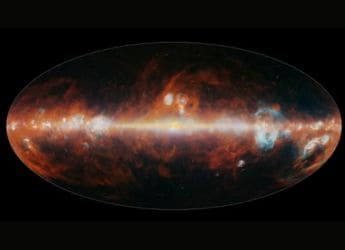- Home
- Science
- Science News
- NASA Says Milky Way's Supermassive Black Hole Has a 'Leak'
NASA Says Milky Way's Supermassive Black Hole Has a 'Leak'
Sagittarius A* is the name of the black hole at the centre of the Milky Way.

Photo Credit: NASA via Daily Mail
An artist’s impression of a the black hole's jet plume
The supermassive black hole at the centre of our galaxy, the Milky Way, has a “leak,” reveals new research. Earlier, scientists had assumed that the supermassive black hole might be a sleeping giant. It was found to reawaken on a regular basis, devouring any star of gas clouds which fell into it. In a long plume or jet of energy, it would then send radiation and particles into space. NASA says the black hole called Sagittarius A* looks like it still has the remnants of a “blowtorch-like jet dating back several thousand years.” However, the space agency has not yet managed to capture the “phantom jet.”
Having stated that, there is “circumstantial evidence” that it is pushing into a huge hydrogen cloud “like the narrow stream from a hose aimed into a pile of sand”. Sagittarius A* has a mass of 4.1 million Suns.
Professor Gerald Cecil of the University of North Carolina at Chapel Hill led the research. A NASA report states that Cecil “pieced together, like a jigsaw puzzle, multiwavelength observations from a variety of telescopes that suggest the black hole burps out mini-jets every time it swallows something hefty, like a gas cloud.” The research report has been published in The Astrophysical Journal.
Using a telescope at the ALMA Observatory in Chile, which uses mm wavelengths to look at objects, Cecil found an “expanding, narrow linear feature in molecular gas that can be traced back at least 15 light-years to the black hole.” Next, Cecil found in images captured by the Hubble Space Telescope “a glowing, inflating bubble of hot gas that aligns to the jet at a distance of at least 35 light-years from the black hole.”
The NASA report quoted the co-author of the study, Alex Wagner of Tsukuba University in Japan, as saying that the streams percolate out of the Milky Way's dense gas disk. Like an octopus, the jet diverges from a pencil beam into tendrils. This outflow forms a sequence of growing bubbles that span at least 500 light-years. According to Wagner, the core black hole's illumination increased by at least a million-fold in the last million years.
On its official YouTube channel of NASA Goddard, the space agency shared a video on the supermassive black hole. It states in the caption, “NASA's Hubble Space Telescope hasn't photographed the phantom jet yet, but it has helped find circumstantial evidence that the jet is still pushing feebly into a huge hydrogen cloud.”
Watch the video here:
Previous observations by Hubble Space Telescope reveal that the black hole had an outburst about two to four million years ago
Get your daily dose of tech news, reviews, and insights, in under 80 characters on Gadgets 360 Turbo. Connect with fellow tech lovers on our Forum. Follow us on X, Facebook, WhatsApp, Threads and Google News for instant updates. Catch all the action on our YouTube channel.
Related Stories
- Samsung Galaxy Unpacked 2025
- ChatGPT
- Redmi Note 14 Pro+
- iPhone 16
- Apple Vision Pro
- Oneplus 12
- OnePlus Nord CE 3 Lite 5G
- iPhone 13
- Xiaomi 14 Pro
- Oppo Find N3
- Tecno Spark Go (2023)
- Realme V30
- Best Phones Under 25000
- Samsung Galaxy S24 Series
- Cryptocurrency
- iQoo 12
- Samsung Galaxy S24 Ultra
- Giottus
- Samsung Galaxy Z Flip 5
- Apple 'Scary Fast'
- Housefull 5
- GoPro Hero 12 Black Review
- Invincible Season 2
- JioGlass
- HD Ready TV
- Laptop Under 50000
- Smartwatch Under 10000
- Latest Mobile Phones
- Compare Phones
- Huawei Nova 15
- Huawei Nova 15 Pro
- Huawei Nova 15 Ultra
- OnePlus 15R
- Realme Narzo 90x 5G
- Realme Narzo 90 5G
- Vivo S50 Pro Mini
- Vivo S50
- Asus ProArt P16
- MacBook Pro 14-inch (M5, 2025)
- Huawei MatePad 11.5 (2026)
- OnePlus Pad Go 2 (5G)
- OnePlus Watch Lite
- Just Corseca Skywatch Pro
- Acerpure Nitro Z Series 100-inch QLED TV
- Samsung 43 Inch LED Ultra HD (4K) Smart TV (UA43UE81AFULXL)
- Asus ROG Ally
- Nintendo Switch Lite
- Haier 1.6 Ton 5 Star Inverter Split AC (HSU19G-MZAID5BN-INV)
- Haier 1.6 Ton 5 Star Inverter Split AC (HSU19G-MZAIM5BN-INV)

















